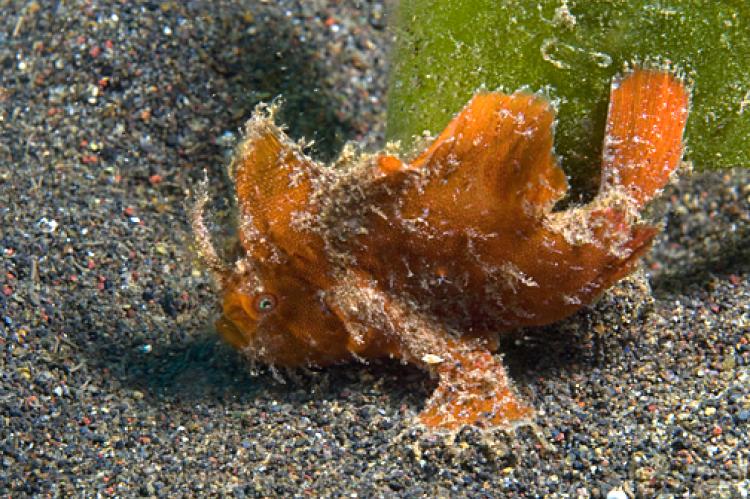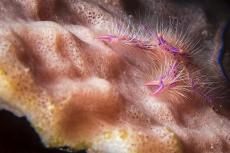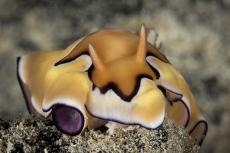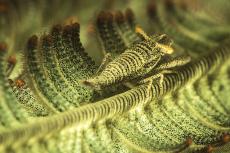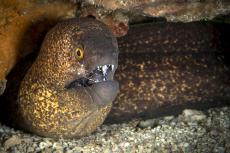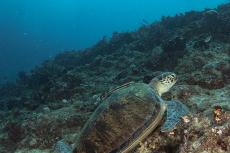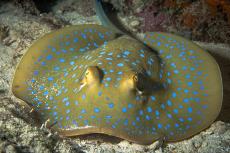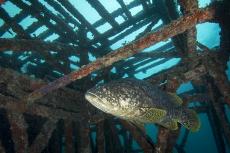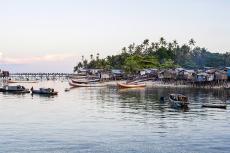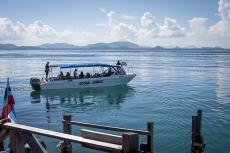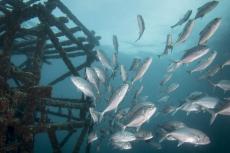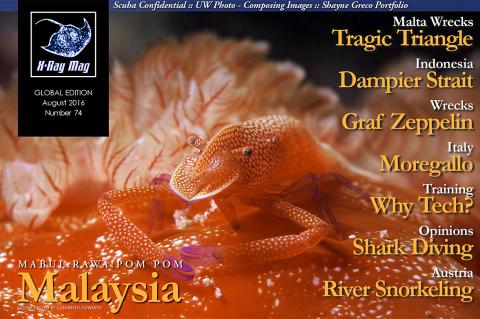Malaysia's Mabul Island
— Eco-Diving in Sabah, the Right Way
As divers, we love the ocean. We have been there, done that, and want to go back as much as possible. We love what we do and spend a lot of money and time traveling to get underwater. In the process, we become some of the ocean’s biggest advocates as we share our adventures and photos, inspiring new divers. I'd venture to say most of us are at least a little environmentally conscious (and lots of us are very environmentally conscious). We learn as much as we can about the ocean, we take part in initiatives to spread the word about ocean welfare, participate in beach cleanups, donate to ocean causes, etc. Diving isn’t just something we do, diving is a lifestyle.
I have just returned from diving Mabul Island, Malaysian Borneo. Part of the coral triangle, this area is literally crawling with muck critters, swarming with fish, and just in view of Sipadan, one of the world’s best dive sites. Needless to say, the diving was good. I spent my time underwater alternating between shooting nudibranchs wishing I had my wide-angle lens as huge turtles and eagle rays swam by, and shooting giant groupers being cleaned inside an artificial reef structure with my wide-angle and finding a nudibranch I’d never seen before, wishing for my macro lens.
But my time staying at Scuba Junkie’s Mabul Beach Resort made me think about dive travel in a slightly different way. We don’t often think of the detriment our travels may be causing, such as unsustainable practices engaged in by the places we stay at or dive with. It’s a bit hypocritical really. We love the ocean, we want to protect it, but environmentally unsound practices could mean that just our diving there may be causing more harm than we realize.
Enter Scuba Junkie.
The environment is a priority for this company and they are doing everything they can to run an eco-friendly operation. The list of awards and accolades they've received goes on and on, and all are much deserved.
I spent a good part of my trip chatting with and diving with their two full-time Environmental Officers, David McCann and Cat Cassidy. Overall, I was left asking myself this question: “Does this really not happen everywhere else?”
Don’t get me wrong, I am not saying that other dive operations or resorts are not making any efforts to be eco-friendly. I know many are, and I’d like to think most try to do what they can with what they have in their specific locales. For every place and every operation, the logistics will be different. In some places, you will not be able to do certain things. But in every place, something can be done. And something should be done. We as consumers, divers and ocean lovers need to demand it.
So what is Scuba Junkie doing that's so special? They use water catchment and solar power to heat the water (I never had a cold shower; in fact, most of the time, I had to turn the heat down), they use biodegradable cleaning products, and they recycle (something which is not easy in Asia). Aluminum gets delivered to one place where it is melted; plastic bottles are delivered to seaweed farmers who can use them, etc. (There's no "one-stop" recycling venue in Semporna.)
They have a sewage system. I know what you're thinking—Sewage? Gross! who thinks about that? Doesn’t every place have that... but they don't. Ask that question the next time you are at a resort or—gasp!—a liveaboard: where does it go when you flush it goodbye? At Scuba Junkie, it is not into the ocean. Rather, the lush green foliage benefits from the compost created post-flush (after going through a complicated-looking system that uses microbes and lots of different tanks in the back of the resort. They are more than willing to show you, if you are interested.) And that’s not all.
Scuba Junkie's environmental projects
One thing I particularly admire is Scuba Junkie’s realization of how important it is that the people of Sabah are involved in their projects and that the project goals are also beneficial to them. Scuba Junkie does not believe in the top-down approach in which they are just telling the local population, “Don’t do that.” Instead, they come up with ways to solve problems that are collectively positive for the people, the businesses, the tourists, and most importantly, the ocean. Their solutions aim to benefit everyone.
Mabul Turtle Hatchery and Rehabilitation Center. This program is my favorite. Turtle eggs (sadly) are a black market commodity and can be sold for extravagant amounts to be used in different types of traditional medicine. These practices have led to turtle nests on Mabul being dug up and the eggs sold before they are allowed to hatch. To stop this, Scuba Junkie (and the Sabah Wildlife Department) offer a monetary reward for the finding of turtle nests. Eggs are then collected and re-nested at the resort’s protected turtle hatchery by trained staff. When the turtles hatch, they can be "adopted" for a contribution to the project, then named and released by the adoptee. The money from adoption then supports the finder’s fee for locals who find the nests. This program has helped to protect the turtles from illegal harvesting while making turtle protection worth more than the illegal sales of turtle eggs—a win-win solution for both the community and the turtles.
The resort also has the capacity to take in injured turtles. While I took a tour of the facilities, fibropapillomatosis was discussed—a terrible disease that is showing up in turtles around the world. Tumors grow on infected turtles, eventually preventing them from seeing and swimming. Dave told me they had not seen this yet around Mabul, then the very next day, we were out diving and saw a turtle covered with the tumors. Sadly, they might be putting their rehab center to more use in the future.
Shark sanctuary. Semporna has a healthy shark population but is an area where sharks are definitely at risk, both directly from potential shark finning and indirectly as by-catch from fishers who accidentally catch them in their nets.
Healthy ray populations also occur. I saw two of the largest eagle rays I’ve ever seen, on my last dive. At first, I thought they were large mantas, but once I got closer, I could see that they were definitely spotted and sported the broad nose of eagle rays.
Scuba Junkie wants this area to be a shark sanctuary, and they are lobbying government authorities, making petitions and also brainstorming a way to make protecting the sharks more worthwhile to the local community, instead of selling the shark fins illegally.
Beach and reef cleans. Weekly beach cleans and reef cleans occur with staff encouraging guests to join in picking up trash.
Outreach. Scuba Junkie gives lectures in-house to guests staying at their resort and also gives presentations to the local communities of Sabah, university students, schools, NGOs, government agencies and more. They participate in Reef Check, a program that collects data on coral and fish species around the world. Each year, they organize week-long Shark Week, Turtle Week and Marine Week programs, giving presentations and having special activities at the resort during those weeks.
Sipadan permit system
Malaysia, as a country, seems fairly onboard with the benefits of environmental protection, as evidenced by measures taken over ten years ago when they created a permit system for diving Sipadan. Before departing for Malaysia, I did the typical Google searches to get a general idea of what to expect. Pretty much every article mentioned two things: Jacques-Yves Cousteau describing the area as “an untouched piece of art”, and that a permit system to dive Sipadan was in place.
So enters the case of an area being "too good", and of us divers basically loving it to death. How does one deal with too many people wanting to experience something to the point of detriment to that which is desired? In Malaysia, they help save an area by putting a limit on diving. Back in 2004, it was mandated that all resorts on the island of Sipadan must be relocated and that a limit would be set on how many divers could dive the island each day. Sipadan has a unique topside environment too, and was made a bird sanctuary in 1933.
Even with the restriction, 120 divers are allowed each day, with most doing three to five dives a day (no night diving is permitted). When you add it up, that is still 300 to 600 individual dives taking place every day around what is a relatively small island (only 12 hectares, or 30 acres). Can you imagine how many dives would have taken place daily if there had not been any restrictions?
The diving
Malaysian Borneo is part of the Coral Triangle, and it is a fish-filled, critter-hunting wonderland. Specifically, the island of Sipadan has had over 3,000 species documented and is definitely a biodiversity hotspot. The spill-off to the nearby islands of Mabul and Kapalai has made them very lush with marine life as well.
Mabul Island is small, and is the location to which most of the Sipadan resorts moved when relocated in 2005. Kapalai Island is really just a sandbar upon which the Kapalai Resort built their lodgings and is now just one big island resort. Both locations have diving all the way around them, with plenty to see. Dive sites vary from mini-wall dives, with sheer drop-offs to around 30m (100ft), to shallow, sloping coral reefs. Lots of sites have man-made artificial structures and boats that have become fantastic artificial reefs.
Artificial reefs
By definition, an artificial reef is a human-made underwater structure, typically built to promote marine life in areas with a generally featureless bottom, to control erosion, block ship passage, or improve surfing.1 Around Mabul and Kapalai, artificial reefs are definitely used to promote marine life and have done a really good job of this.
Man-made structures were a common sight on many of my dives. Sunken fishing boats placed in front of resorts liven up house reefs. Pyramid-shaped wooden objects and even giant castle-like buildings are found at many dive sites. Some may consider them an eyesore, and I agree with that—from a distance, some look pretty strange, but they have done an immense job of attracting critters, especially those muck critters we love so much.
After diving a site actually called "Artificial Reef”, I asked Dave, one of the Environmental Officers, if these sunken vessels and artifacts were being used to fix damaged areas like dynamited or eroded coral areas, and he said, mostly no. On one side of Kapalai, it is naturally sandy, and the structures have attracted life to an otherwise barren area. He also mentioned the artificial reefs’ importance in dive training, as beginner divers sometimes take a little while to get skilled with their buoyancy. So, taking new divers to the artificial reefs cuts down on the potential reef destruction while these new divers are learning.
I loved the artificial reefs for their macro life. Blue dragon nudibranchs seemed to love the wooden structures, and many other species of nudibranchs were also found on them. Lots of reef fish were seen feeding on the growth on the structures and possibly using them as a safe haven from predation. Ghost pipefish, frogfish, scorpionfish, flatworms and more were found in my hunts. And not everything I saw was tiny. Huge groupers were seen several times, and also at Artificial Reef, there is a massive school of trevally that swim in and out among the structures.
There were also some really nice coral areas that are blazing with orange, pink and purple soft corals and sponges. Similarly, bright-colored anthias flitted around the reef like colorful rain, and there were also large schools of reef fish like blue-striped snappers, goatfish and fusiliers. Turtles were in massive abundance, and they were huge! I remember seeing the first turtle and being overwhelmed by how large it was, and then right behind it, were two more giant turtle shadows swimming towards us.
I did not get to dive Sipadan on this trip, I guess you can call me a causality of the permit system. From what other divers told me, there were large schools of bumphead parrotfish, a whitetip shark feeding frenzy and beautiful coral reef life descending down sheer walls. They also went on and on about how fantastic it was. I guess I have something to come back for. If you do plan on making a trip here, be sure to book early during the high season to make sure you get a permit.
Dive training
Although I didn’t do any dive training while at Scuba Junkie, I was very impressed by their training program. As a PADI IDC Staff Instructor, I can’t help but eavesdrop a little on instruction going on, and I was impressed with what I saw. They do a huge amount of training—a rough estimate was over 5,000 certifications a year—and with the resort taking up to 68 guests a night (they were close to full the week I was there), you can only imagine how much is going on every day, with both serious training as well as dives just for fun.
Their dedication to the environment is also clear in their teaching. New divers (and experienced divers who may just be diving and not taking classes) are thoroughly schooled in environmentally-conscious diving. No fins on the reef, no touching, no taking of souvenirs, etc. It was really good to see this instruction, and see it enforced on dives. There’s nothing worse than seeing a diver kick and destroy a piece of coral (even if by accident), and the dive instructors and guides do all they can to make sure new divers become good divers.
We can make a difference
I want to leave you with a challenge. Do the research before you decide to spend money at a particular dive resort or operation. Being a diver, you, no doubt, love the ocean and at least on some level care about what happens to it and its future. Invest in dive operations that are working towards sustainability and conservation projects. Let’s make operations like Scuba Junkie the norm. Require those who make a living off the ocean to do it while leaving the smallest footprint possible.
As we see here, it can be done, and it is being done at a few other cherished locations around the world too. As consumers, we can shape these practices by supporting sustainability and conservation. Don't support those who are unwilling to make these changes. Force them to do the right thing and run operations the right way. Hopefully, we will be able to bring our children and grandchildren to these amazing underwater masterpieces and they will still be in as good a condition, if not better, than when we last saw them.
I want to leave the dive industry with a challenge as well. Why isn't every dive resort and operation making these efforts? It will likely cost something, of course, but as an industry that relies on the state of the ocean, shouldn’t the dive industry as a whole make an effort to conserve the oceans and reefs? It seems like a no-brainer, and there are many dive businesses that are already doing the right thing. We need to support these conscientious operations and demand that the other places where we spend our money make similar efforts.
We, individually, need to help too. Do we really need that towel changed today? Can we bring our own water bottles and refill them instead of buying a new one each time? Must we really spend 20 minutes in the shower? We can make these changes in our lives every day too, because even if we live in a land-locked area far from the ocean, what we do affects the ocean. Little things do matter, and it will take all of us to make a change. ■
Thanks go to Ric Owen and Scuba Junkie Mabul Beach Resort as well as Ness Puvanes and MIDE for their generous support and assistance.
Brandi Mueller is a PADI IDC Staff Instructor and boat captain living in the Marshall Islands. When she’s not teaching scuba or driving boats, she’s most happy traveling and being underwater with a camera. For more information, visit: Brandiunderwater.com.
REFERENCES:
1 https://en.wikipedia.org/wiki/Artificial_reef
ScubaJunkie.com
Sipadan.com
Want to learn more about which environmentally friendly operations to dive with in Asia? Check out GreenFins.net
Download the full article ⬇︎
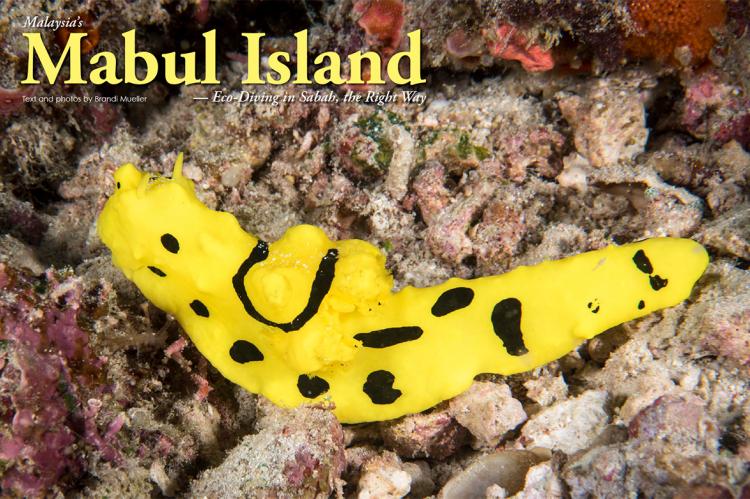
Originally published
X-Ray Mag #74
Malaysia's Mabul Island, Pulau Rawa and Pom Pom Island; Indonesia's Dampier Strait; River snorkeling in Austria; Italy's submerged machines at Moregallo; The Graf Zeppelin wreck; U-Boat Navigator explores wrecks of Malta; Scuba Confidential: Choose Wisely; To shark dive or not to shark dive; Composing images underwater; Shayne Greco portfolio; Plus news and discoveries, equipment and training news, books and media, underwater photo and video equipment, shark tales, whale tales and much more...


